Using the Effective Void Ratio and Specific Surface Area in the Kozeny–Carman Equation to Predict the Hydraulic Conductivity of Loess
Abstract
:1. Introduction
2. Background and Theoretical
2.1. Concept and Development of the Effective Void Ratio for Clays
2.2. Definition and Application of Specific Surface Area (SSA) in the KC Equation
- (i)
- S is the total surface area per unit bulk volume of porous medium, , in cm2/cm3;
- (ii)
- S0 is the grain-related specific surface area, defined as the surface area per unit grain volume, , in cm2/cm3;
- (iii)
- Sp is the surface area per unit volume of pore space, , in cm2/cm3;
- (iv)
- Sg is the sum surface area per unit mass particle, Sg = S0/ρs, in m2/kg.
2.3. Modified KC Equation with Effective Void Ratio (ee)
3. Materials and Experiments
3.1. Materials
3.1.1. Loess in China
3.1.2. Analyzed Deposits and Properties
3.2. Experiments
3.2.1. Permeability Measurements
3.2.2. Determination of BET-N2 Specific Surface Area
4. Results and Analysis
4.1. Estimates of the Effective Void Ratio for Loess
4.2. Estimation of Specific Surface Area for Loess
4.3. Application and Evaluation
4.3.1. Verification of KC Equation Base on ne and Dg Correction
4.3.2. Verification of KC Equation Base on e and m Correction
5. Discussion
5.1. Uncertainty of the Effective Porosity Ratio
5.2. Uncertainty in the Specific Surface Area
5.3. Influence of the Uniformity of Remolded Specimens
- (1).
- The sample preparation method for remolded soil may affect the results of the osmotic test. Some studies show that the seepage stability of static compacted specimens is obviously superior to that of impact and kneading methods [72]. Concurrently, the stability of a static compacted specimen also is affected by the initial dry density and moisture content. Generally, the stability of compacted specimens increases with increasing initial dry density and water content. Regarding impacted samples, the lower part of the sample is usually denser than the upper layer, and local blockage of the sample occurs [21]. Accompanying the decrease in porosity, the seepage path zigzags more. Simultaneously, the site surface between the layers forms a relatively dense structure, similar to the weak permeable layer in the stratum, resulting in the underestimation of the measured Ks. Additionally, for a specimen with a low initial water content, the Ks of the specimen bottom may increase due to the occurrence of microcracks during compaction.
- (2).
- Remolded soil samples may be affected by the predominance of seepage in the formation of larger pores. Although different authors give different pore boundary diameters for large pores (or larger pores or macropores), it is difficult to measure and quantify this value under high seepage [73]. Jang et al. [74] showed that, according to simulation results of a pore network model, 10% of the large holes may contribute to 50% of the total flow. However, this is not the true reflection of the soil system.
- (3).
- Tortuous/pore-throat effect. Although the structures of joints, fissures and aggregates are destroyed in remolded soil, a more uniform pore structure is formed by the remolding process. However, compacted clay is composed of different mineral particles. Under the influence of compaction energy, macropores may be discontinuous and the action of pore throats will restrict the adjacent large pores [75]. The existence of the pore throats greatly increases the seepage paths. The results of a study by Kucza and Ilek [76] on the permeability of irregularly shaped specimens are described as follows. Kucza and Ilek [76] report that water conductivity measurement errors are minimal for these specimens due to the continuous variation in the sample cross section, and the lateral surface change of a sample is the dominant factor of measurement errors. That is, we can see an irregular sample as a single irregularly shaped capillary and the lateral surface can be seen as a meandering flow path, i.e., tortuosity. The seepage path becomes longer due to the limitation of the pore throat, that is, the lateral surface described by Kucza and Ilek [76] of the sample is increased, which results in the overestimation or underestimation of the measured Ks. However, Olsen [19] does not consider the tortuous path of the seepage to completely explain the difference between the predicted and the measured Ks.
5.4. Test Process Control
6. Conclusions
Author Contributions
Funding
Conflicts of Interest
References
- Meegoda, N.; Gunasekera, S. A New Method to Measure the Effective Porosity of Clays. Geotech. Test. J. 1992, 15, 340–351. [Google Scholar] [CrossRef]
- Boadu, F.K. Hydraulic Conductivity of Soils from Grain-Size Distribution: New Models. J. Geotech. Geoenviron. Eng. 2000, 126, 739–746. [Google Scholar] [CrossRef]
- Ahuja, L.R.; Naney, J.W.; Green, R.E.; Nielsen, D.R. Macroporosity to Characterize Spatial Variability of Hydraulic Conductivity and Effects of Land Management. Soil Sci. Soc. Am. J. 1984, 48, 699–702. [Google Scholar] [CrossRef]
- Ahuja, L.R.; Naney, J.W.; Williams, R.D. Estimating Soil Water Characteristics from Simpler Properties or Limited Data. Soil Sci. Soc. Am. J. 1985, 49, 1100–1105. [Google Scholar] [CrossRef]
- Schaap, M.G.; Lebron, I. Using microscope observations of thin sections to estimate soil permeability with the Kozeny–Carman equation. J. Hydrol. 2001, 251, 186–201. [Google Scholar] [CrossRef]
- Regalado, C.M.; Muñoz-Carpena, R. Estimating the saturated hydraulic conductivity in a spatially variable soil with different permeameters: A stochastic Kozeny–Carman relation. Soil Tillage Res. 2004, 77, 189–202. [Google Scholar] [CrossRef]
- Song, J.; Chen, X.; Cheng, C.; Wang, D.; Lackey, S.; Xu, Z. Feasibility of grain-size analysis methods for determination of vertical hydraulic conductivity of streambeds. J. Hydrol. 2009, 375, 428–437. [Google Scholar] [CrossRef]
- Urumović, K.; Urumović, K., Sr. The effective porosity and grain size relations in permeability functions. Hydrol. Earth Syst. Sci. Discuss. 2014, 11, 6675–6714. [Google Scholar] [CrossRef]
- Urumović, K.; Urumović Sr, K. The referential grain size and effective porosity in the Kozeny–Carman model. Hydrol. Earth Syst. Sci. 2016, 20, 1669–1680. [Google Scholar] [CrossRef] [Green Version]
- Kozeny, J. Uber Kapillare Leitung der Wasser in Boden. R. Acad. Sci. Vienna Proc. Cl. I 1927, 136, 271–306. [Google Scholar]
- Carman, P.C. Permeability of saturated sands, soils and clays. J. Agric. Sci. 1939, 29, 262–273. [Google Scholar] [CrossRef]
- Carman, P.C. Flow of Gas Through Porous Media; Butterworths Scientific Publications: London, UK, 1956. [Google Scholar]
- Bear, J. Dyinamics of Fluid in Porous Media; Elsevier: New York, NY, USA, 1972. [Google Scholar]
- Todd, D.K. Ground Water Hydrology; John Wiley and Sons, Inc.: New York, UY, USA, 1959. [Google Scholar]
- Irani, R.; Callis, C. Particle Size: Measurement, Interpretation and Application; John Wiley and Sons: New York, NY, USA, 1963. [Google Scholar]
- Taylor, D.W. Fundamentals of Soil Mechanics; Wiley: New York, NY, USA, 1948; p. xii. [Google Scholar]
- Michaels, A.S.; Lin, C.S. Permeability of kaolinite. Ind. Eng. Chem. 1954, 46, 1239–1246. [Google Scholar] [CrossRef]
- Carrier, W.D., III. Goodbye, Hazen; Hello, Kozeny-Carman. J. Geotech. Geoenviron. Eng. 2003, 129, 1054–1056. [Google Scholar] [CrossRef]
- Olsen, H.W. Hydraulic flow through saturated clays. In Clays Clay Miner; Ingerson, E., Ed.; Springer: Pergamon, Turkey, 1962; pp. 131–161. [Google Scholar] [CrossRef]
- Zhang, M.; Zhu, X.; Yu, G.; Yan, J.; Wang, X.; Chen, M.; Wang, W. Permeability of muddy clay and settlement simulation. Ocean Eng. 2015, 104, 521–529. [Google Scholar] [CrossRef]
- Chapuis, R.P.; Aubertin, M. On the use of the Kozeny–Carman equation to predict the hydraulic conductivity of soils. Can. Geotech. J. 2003, 40, 616–628. [Google Scholar] [CrossRef]
- Ren, X.; Zhao, Y.; Deng, Q.; Kang, J.; Li, D.; Wang, D. A relation of hydraulic conductivity-void ratio for soils based on Kozeny-Carman equation. Eng. Geol. 2016, 213, 89–97. [Google Scholar] [CrossRef]
- Santamarina, J.C.; Klein, K.A.; Wang, Y.H.; Prencke, E. Specific surface: Determination and relevance. Can. Geotech. J. 2002, 39, 233–241. [Google Scholar] [CrossRef]
- Farrar, D.M.; Coleman, J.D. The correlation of surface area with other properties of nineteen British clay soils. J. Soil Sci. 1967, 18, 118–124. [Google Scholar] [CrossRef]
- Li, X.-A.; Li, L.-C. Quantification of the pore structures of Malan loess and the effects on loess permeability and environmental significance, Shaanxi Province, China: An experimental study. Environ. Earth Sci. 2017, 76, 523. [Google Scholar] [CrossRef]
- Li, X.-A.; Li, L.-C.; Song, Y.-X.; Hong, B.; Wang, L.; Sun, J.-Q. Characterization of the mechanisms underlying loess collapsibility for land-creation project in Shaanxi Province, China—A study from a micro perspective. Eng. Geol. 2018, 249, 77–88. [Google Scholar] [CrossRef]
- Koponen, A.; Kataja, M.; Timonen, J. Permeability and effective porosity of porous media. Phys. Rev. E 1997, 56, 3319–3325. [Google Scholar] [CrossRef]
- Dang, F.N.; Liu, H.W.; Wang, X.W.; Xue, H.B.; Ma, Z.Y. Researching clayey empirical formula of permeability coefficient based on the theory of effective porosity ratio. Chin. J. Rock Mech. Eng. 2015, 34, 1909–1917. [Google Scholar]
- Kou, L.; Xu, J.G.; Wang, B. Research on Grouting Infiltration Mechanism for Time-Dependent Viscous Slurry Considering Effective Void Ratios in Saturated Clay. Appl. Math. Mech. 2018, 39, 83–91. [Google Scholar]
- Bodman, G.B.; Harradine, E.F. Mean Effective Pore Size and Clay Migration during Water Percolation in Soils. Soil Sci. Soc. Am. J. 1939, 3, 44–51. [Google Scholar] [CrossRef]
- Stephens, D.B.; Hsu, K.-C.; Prieksat, M.A.; Ankeny, M.D.; Blandford, N.; Roth, T.L.; Kelsey, J.A.; Whitworth, J.R. A comparison of estimated and calculated effective porosity. Hydrogeol. J. 1998, 6, 156–165. [Google Scholar] [CrossRef]
- Muhunthan, B. Liquid limit and surface area of clays. Géotechnique 1991, 41, 135–138. [Google Scholar] [CrossRef]
- Salem, H.S. Application of the Kozeny-Carman Equation to Permeability Determination for a Glacial Outwash Aquifer, Using Grain-size Analysis. Energy Sources 2001, 23, 461–473. [Google Scholar] [CrossRef]
- Korvin, G. Permeability from Microscopy: Review of a Dream. Arabian J. Sci. Eng. 2016, 41, 2045–2065. [Google Scholar] [CrossRef]
- Sepaskhah, A.R.; Tabarzad, A.; Fooladmand, H.R. Physical and empirical models for estimation of specific surface area of soils. Arch. Agron. Soil Sci. 2010, 56, 325–335. [Google Scholar] [CrossRef]
- Shirazi, M.A.; Boersma, L. A Unifying Quantitative Analysis of Soil Texture. Soil Sci. Soc. Am. J. 1984, 48, 142–147. [Google Scholar] [CrossRef]
- De Bruyn, C.M.A.; Collins, L.F.; Williams, A.A.B. The Specific Surface, Water Affinity, and Potential Expansiveness of Clays. Clay Miner. Bull. 1957, 3, 120–128. [Google Scholar] [CrossRef]
- Hammel, J.E.; Sumner, M.E.; Burema, J. Atterberg Limits as Indices of External Surface Areas of Soils1. Soil Sci. Soc. Am. J. 1983, 47, 1054–1056. [Google Scholar] [CrossRef]
- Smith, C.W.; Hadas, A.; Dan, J.; Koyumdjisky, H. Shrinkage and Atterberg limits in relation to other properties of principal soil types in Israel. Geoderma 1985, 35, 47–65. [Google Scholar] [CrossRef]
- Wetzel, A. Interrelationships between porosity and other geotechnical properties of slowly deposited, fine-grained marine surface sediments. Mar. Geol. 1990, 92, 105–113. [Google Scholar] [CrossRef]
- Churchman, G.J.; Burke, C.M.; Parfitt, R.L. Comparison of various methods for the determination of specific surfaces of sub soils. J. Soil Sci. 1991, 42, 449–461. [Google Scholar] [CrossRef]
- Churchman, G.J.; Burke, C.M. Properties of sub soils in relation to various measures of surface area and water content. J. Soil Sci. 1991, 42, 463–478. [Google Scholar] [CrossRef]
- Steiakakis, E.; Gamvroudis, C.; Alevizos, G. Kozeny-Carman Equation and Hydraulic Conductivity of Compacted Clayey Soils. Geomaterials 2012, 2, 37–41. [Google Scholar] [CrossRef] [Green Version]
- Mbonimpa, M.; Aubertin, M.; Chapuis, R.P.; Bussière, B. Practical pedotransfer functions for estimating the saturated hydraulic conductivity. Geotech. Geol. Eng. 2002, 20, 235–259. [Google Scholar] [CrossRef]
- Arnepalli, D.N.; Shanthakumar, S.; Hanumantha Rao, B.; Singh, D.N. Comparison of Methods for Determining Specific-surface Area of Fine-grained Soils. Geotech. Geol. Eng. 2008, 26, 121–132. [Google Scholar] [CrossRef]
- Yukselen-Aksoy, Y.; Kaya, A. Method dependency of relationships between specific surface area and soil physicochemical properties. Appl. Clay Sci. 2010, 50, 182–190. [Google Scholar] [CrossRef]
- Lȕ, H.B.; Qian, L.Y.; Chang, H.S.; Liu, L.; Zhao, Y.L. Comparison of several methods for determining specific surface area of clayey soils. Chin. J. Geotech. Eng. 2016, 38, 124–131. [Google Scholar]
- Liu, T.; Ding, Z. Chinese loess and the paleomonsoon. Annu. Rev. Earth Planet. Sci. 1998, 26, 111–145. [Google Scholar] [CrossRef]
- Liu, T.S. The Loess Deposits in China; Science Press: Beijing, China, 1965. [Google Scholar]
- Li, B.; Wang, L. Statistical analysis of precipitation in the past 60 years in Yan’an. Shaanxi Water Res. 2015, 126–129. [Google Scholar] [CrossRef]
- Dang, X.; Liu, H. Analysis of climate change trend of Yanchuan County of Shaanxi Province in recent 30 years. Beijing Agric. 2015, 143–144. [Google Scholar] [CrossRef]
- Shang, X.; Zhao, X.; Gao, F.; Zhang, Y.; Ma, L. Analysis of climate change characteristics of Jingyang in the last 58 years. J. Shaanxi Meteorol. 2014, 1–4. [Google Scholar] [CrossRef]
- Gu, Z.W.; Sun, B.N.; Dong, Y.N. Testing Study of Permeability of the Original Clay, Recomposed Clay and Improved Clay with Stabilizer ZDYT-1. Chin. J. Rock Mech. Eng. 2003, 22, 505–508. [Google Scholar]
- Gao, Y.Y.; Qian, H.; Yang, J.; Feng, J.; Huo, C.C. Indoor experimental study on permeability characteristics of remolded Malan Loess. South-to-North Water Transf. Water Sci. Technol. 2016, 14, 130–136. [Google Scholar]
- Hong, B.; Li, X.A.; Chen, G.D.; Luo, J.W.; Li, L.C. Experimental study of permeability of remolded Malan Loess. J. Eng. Geol. 2016, 24, 276–283. [Google Scholar]
- Yang, B.; Zhang, H.Y.; Zhao, T.Y.; Liu, J.S.; Chen, H. Responsibility of permeability of modified loess soil on microstructure. Hydrogeol. Eng. Geol. 2011, 38, 96–101. [Google Scholar]
- Locat, J.; Lefebvre, G.; Ballivy, G. Mineralogy, chemistry, and physical properties interrelationships of some sensitive clays from Eastern Canada. Can. Geotech. J. 1984, 21, 530–540. [Google Scholar] [CrossRef]
- Sridharan, A.; Rao, S.M.; Murthy, N.S. Liquid Limit of Montmorillonite Soils. Geotech. Test. J. 1986, 9, 156–159. [Google Scholar] [CrossRef]
- Sridharan, A.; Rao, S.M.; Murthy, N.S. Liquid limit of kaolinitic soils. Géotechnique 1988, 38, 191–198. [Google Scholar] [CrossRef]
- Olchawa, A.; Gorączko, A. The relationship between the liquid limit of clayey soils, external specific surface area and the composition of exchangeable cations/Zależność granicy płynności od zewnętrznej powierzchni właściwej i składu kationów w naturalnym kompleksie wymiennym. J. Water Land Dev. 2012, 17, 83–88. [Google Scholar] [CrossRef] [Green Version]
- Yukselen, Y.; Kaya, A. Comparison of Methods for Determining Specific Surface Area of Soils. J. Geotech. Geoenviron. Eng. 2006, 132, 931–936. [Google Scholar] [CrossRef]
- Sun, M.L. Analysis of the Specific Surface Area of Loess in Lanzhou. Master’s Thesis, Lanzhou University, Lanzhou, China, 2014. [Google Scholar]
- Dolinar, B.; Trauner, L. Liquid Limit and Specific Surface of Clay Particles. Geotech. Test. J. 2004, 27, 580–584. [Google Scholar] [CrossRef]
- Cerato, A.; Lutenegger, A. Determination of Surface Area of Fine-Grained Soils by the Ethylene Glycol Monoethyl Ether (EGME) Method. Geotech. Test. J. 2002, 25, 315–321. [Google Scholar] [CrossRef]
- Maček, M.; Mauko, A.; Mladenovič, A.; Majes, B.; Petkovšek, A. A comparison of methods used to characterize the soil specific surface area of clays. Appl. Clay Sci. 2013, 83, 144–152. [Google Scholar] [CrossRef]
- Shah, P.H.; Singh, D. Generalized Archie’s Law for Estimation of Soil Electrical Conductivity. J. ASTM Int. 2005, 2, 1–20. [Google Scholar] [CrossRef]
- Yan, X.D.; Zhang, F.Y.; Liang, S.Y.; Wu, W.J.; Zhang, J.X. Characteristics of Special Surface Area and Cation Exchange Capacity of Lime-stabilized Loess. Acta Scientiarum Naturalium Universitatis Sunyatseni 2014, 53, 149–154. [Google Scholar]
- Liang, J.W. Experimental Study on Soft Soil Deformation and Seepage Characteristics with Microscopic Parameter Analysis. Ph.D. Thesis, South China University of Technology, Guangzhou, China, 2010. [Google Scholar]
- Tanaka, H.; Locat, J. A microstructural investigation of Osaka Bay clay: The impact of microfossils on its mechanical behaviour. Can. Geotech. J. 1999, 36, 493–508. [Google Scholar] [CrossRef]
- Li, S.M.; Liu, Z.K.; Mu, C.M.; Meng, J.P.; He, T.J.; Chen, J.Y.; Gong, Y. Determination method of effective void ratio for lateritic soil. J. Guilin Univ. Technol. 2017, 37, 429–436. [Google Scholar]
- Yukselen, Y.; Kaya, A. Suitability of the methylene blue test for surface area, cation exchange capacity and swell potential determination of clayey soils. Eng. Geol. 2008, 102, 38–45. [Google Scholar] [CrossRef]
- Seed, H.B. Stability and Swell Pressure Characteristics of Compacted Clays. Clays Clay Miner. 1954, 3, 483–504. [Google Scholar] [CrossRef]
- Allaire, S.E.; Roulier, S.; Cessna, A.J. Quantifying preferential flow in soils: A review of different techniques. J. Hydrol. 2009, 378, 179–204. [Google Scholar] [CrossRef]
- Jang, J.; Narsilio, G.A.; Santamarina, J.C. Hydraulic conductivity in spatially varying media—A pore-scale investigation. Geophys. J. Int. 2011, 184, 1167–1179. [Google Scholar] [CrossRef] [Green Version]
- Dixon, D.A.; Graham, J.; Gray, M.N. Hydraulic conductivity of clays in confined tests under low hydraulic gradients. Can. Geotech. J. 1999, 36, 815–825. [Google Scholar] [CrossRef]
- Kucza, J.; Ilek, A. The effect of the shape parameters of a sample on the hydraulic conductivity. J. Hydrol. 2016, 534, 230–236. [Google Scholar] [CrossRef]
- Chapuis, R.P.; Baass, K.; Davenne, L. Granular soils in rigid-wall permeameters: Method for determining the degree of saturation. Can. Geotech. J. 1989, 26, 71–79. [Google Scholar] [CrossRef]
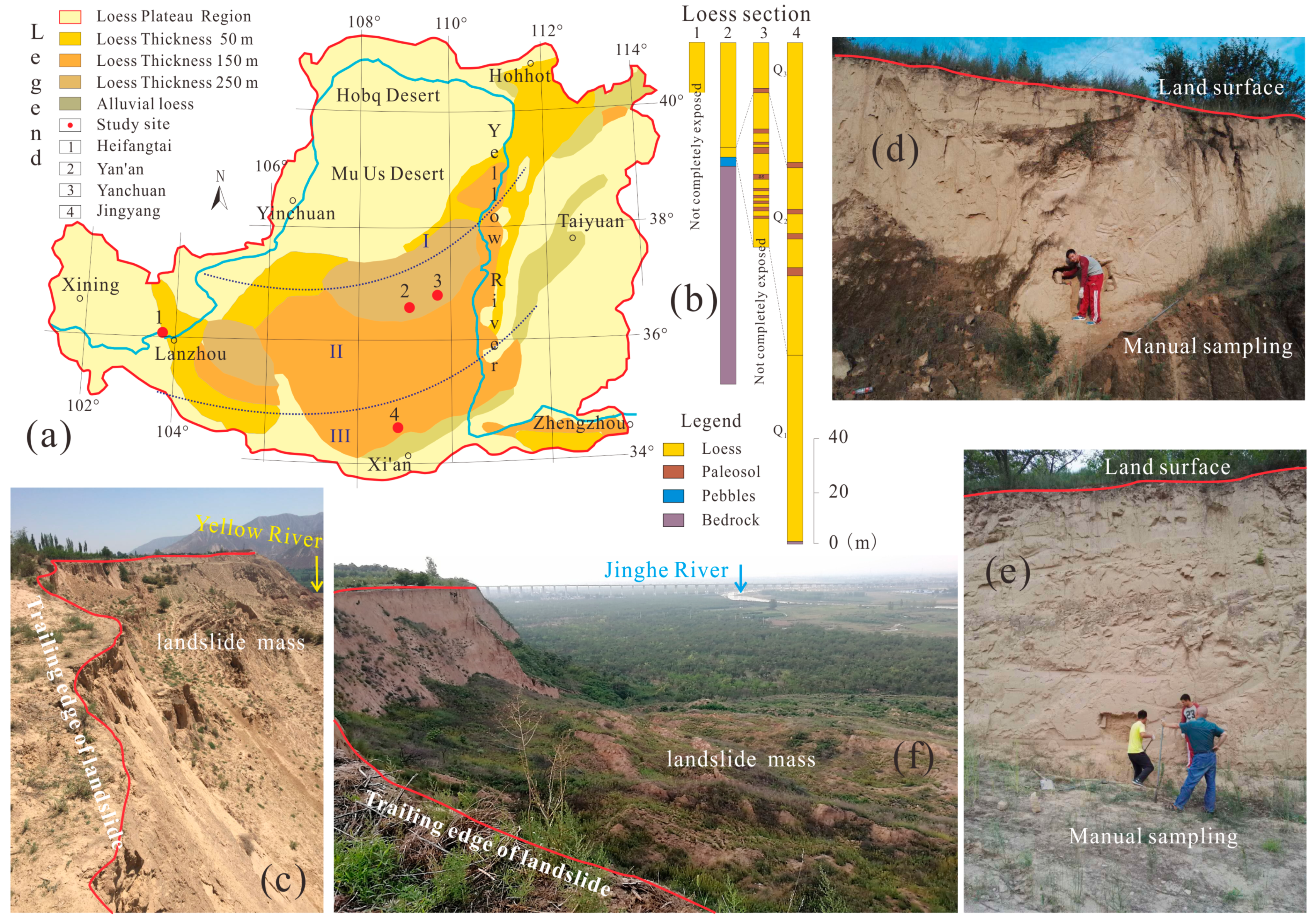
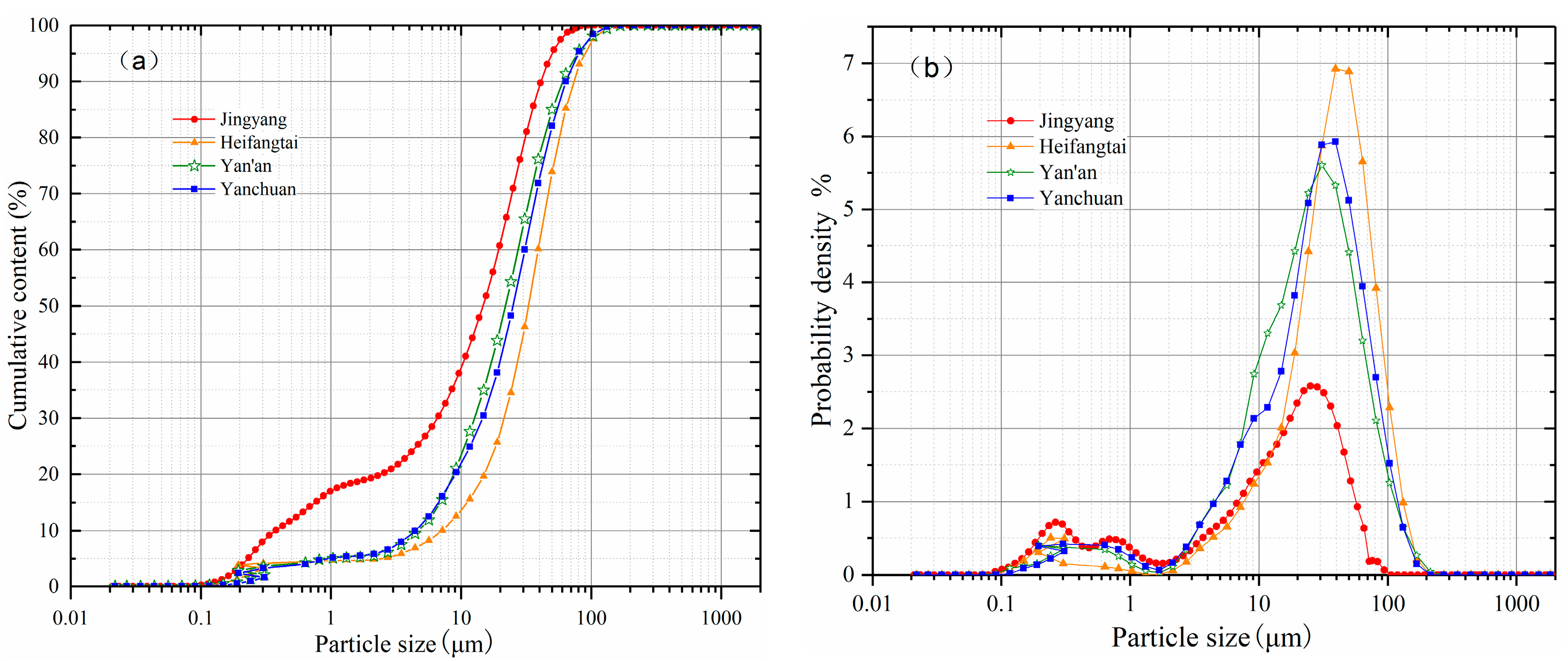
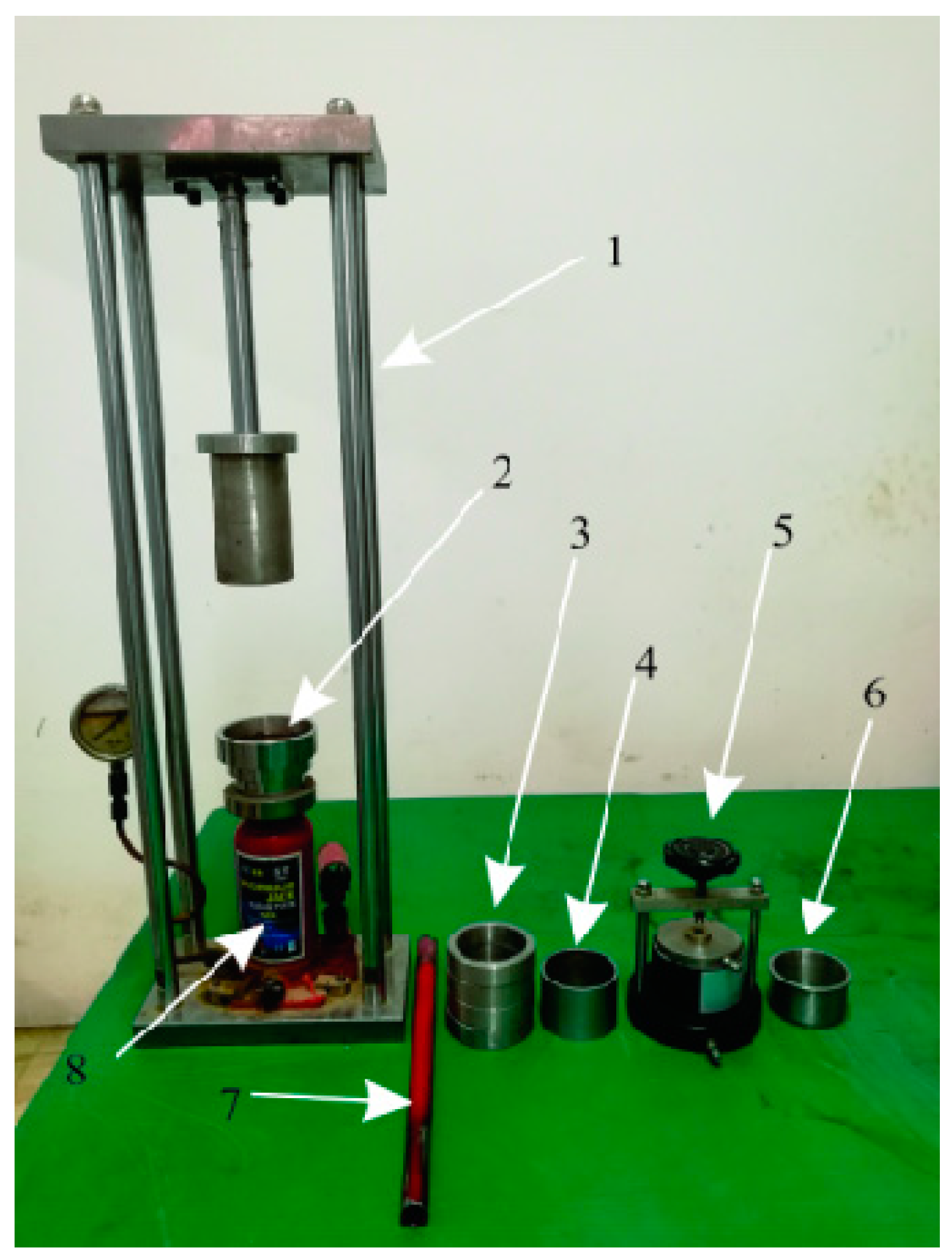




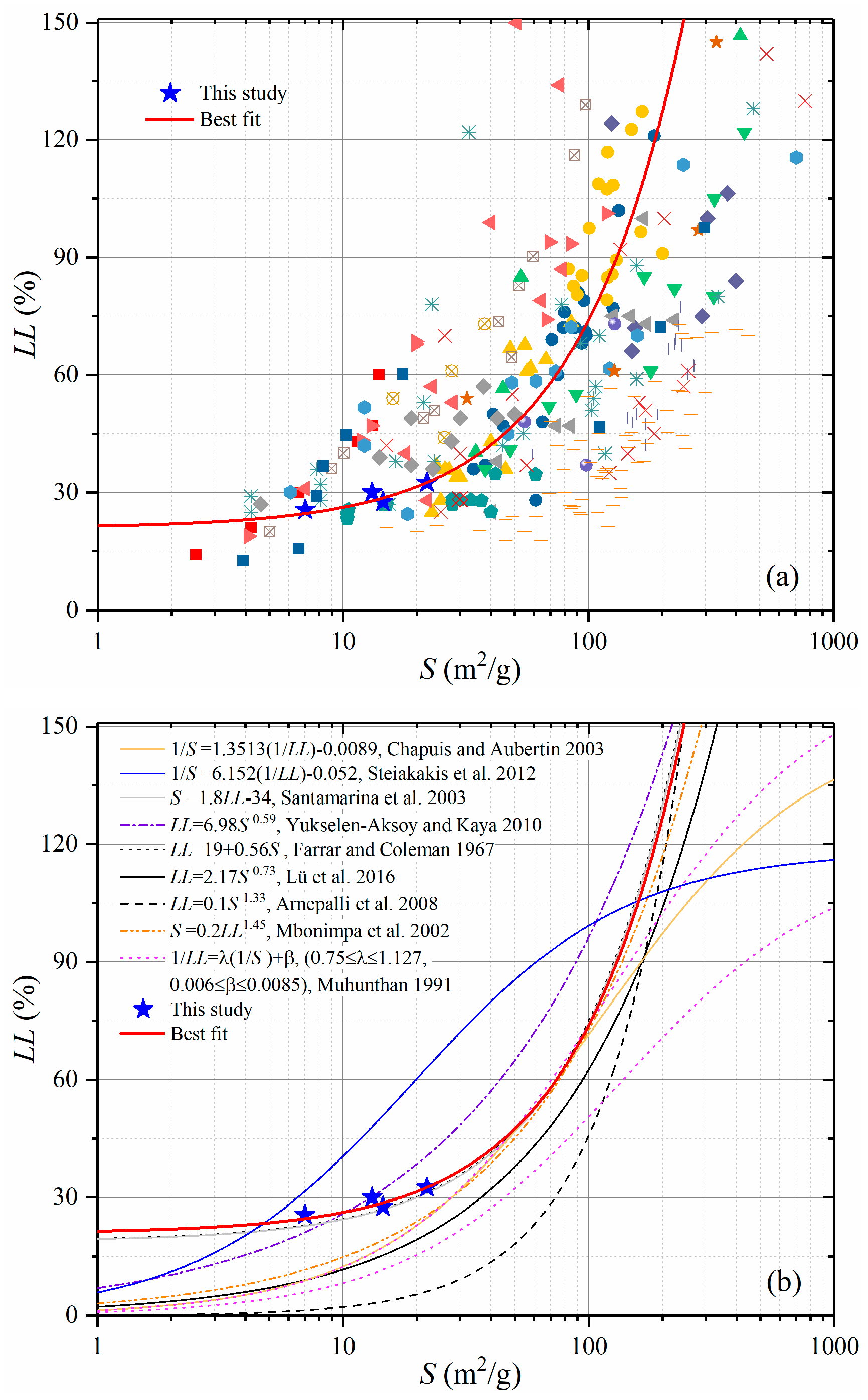

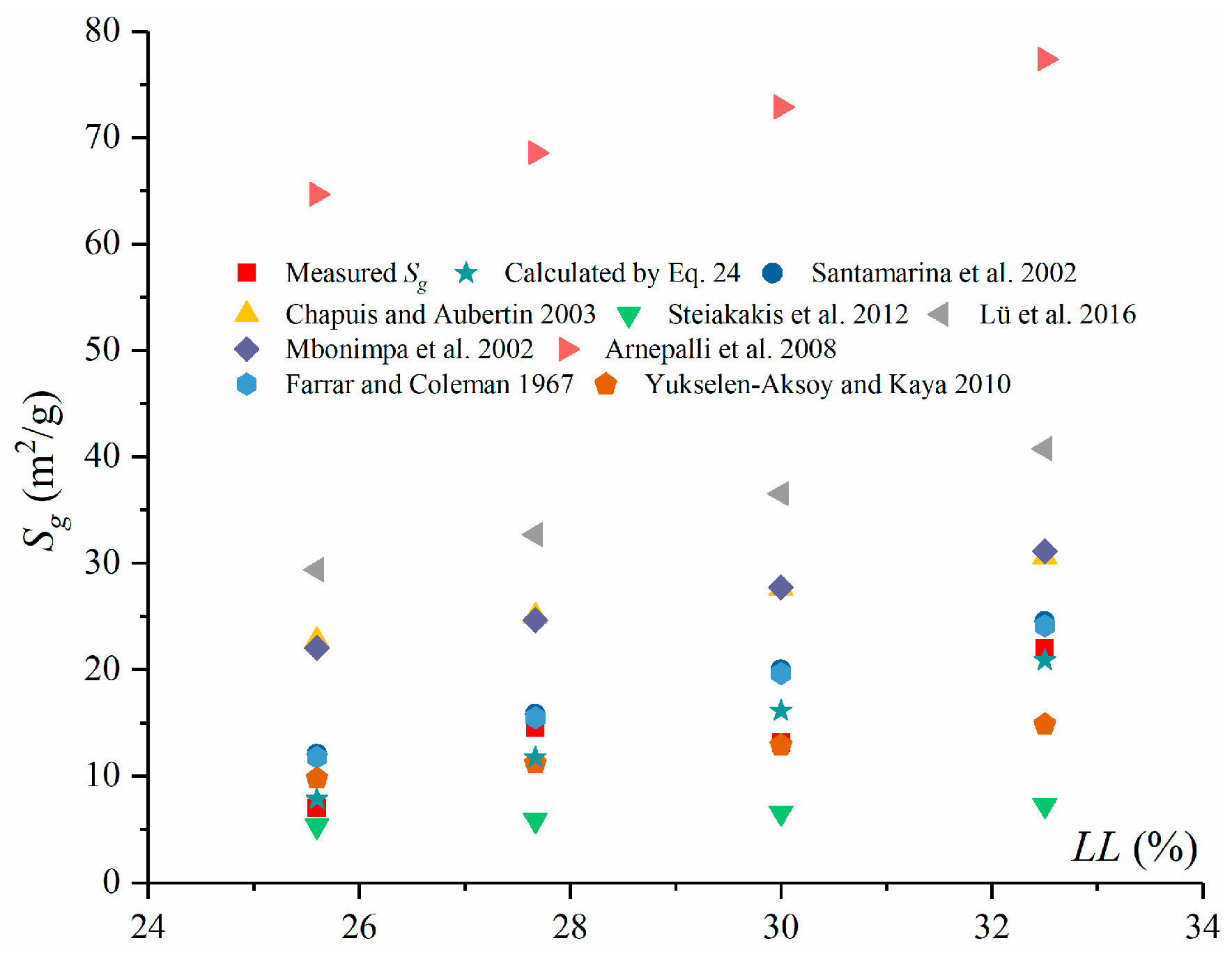
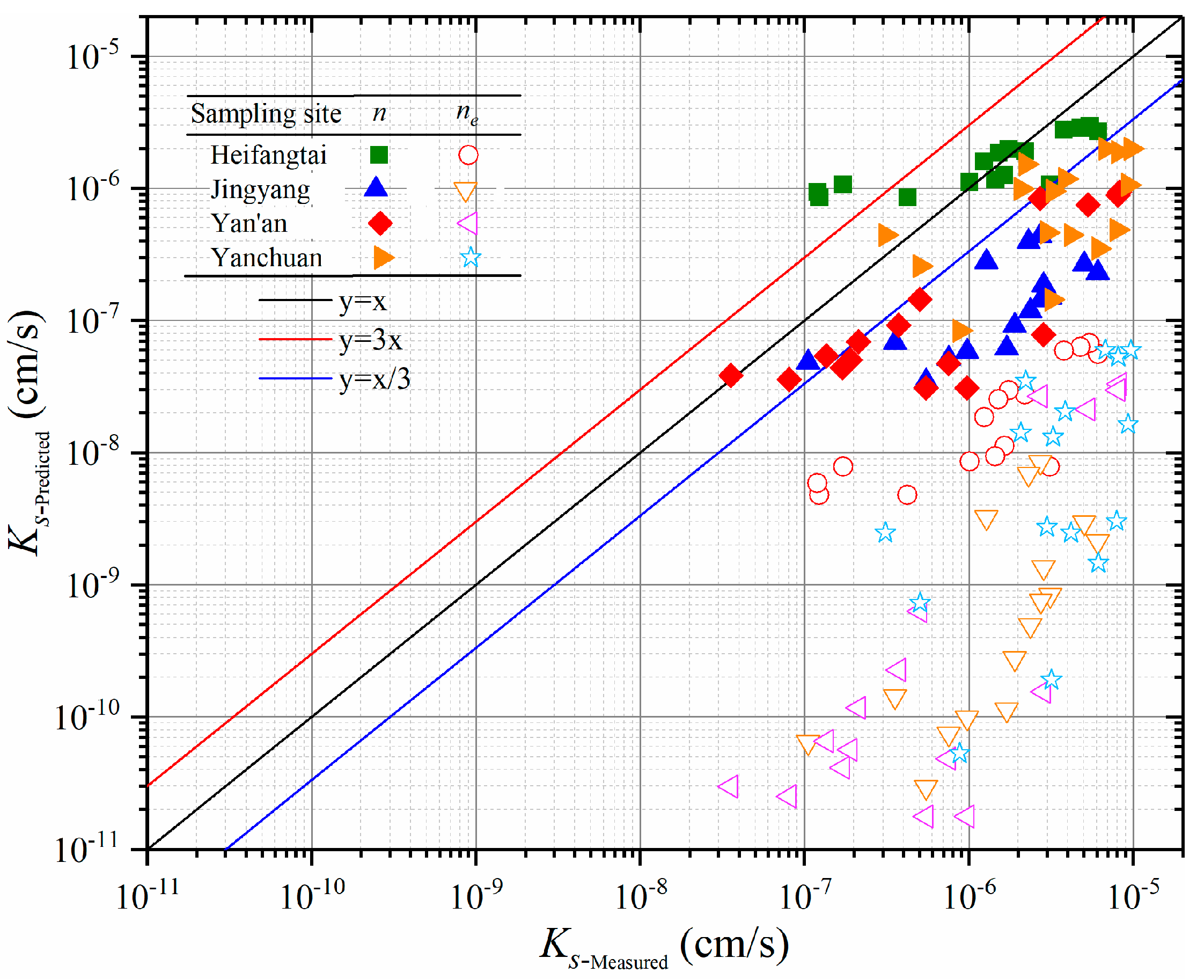
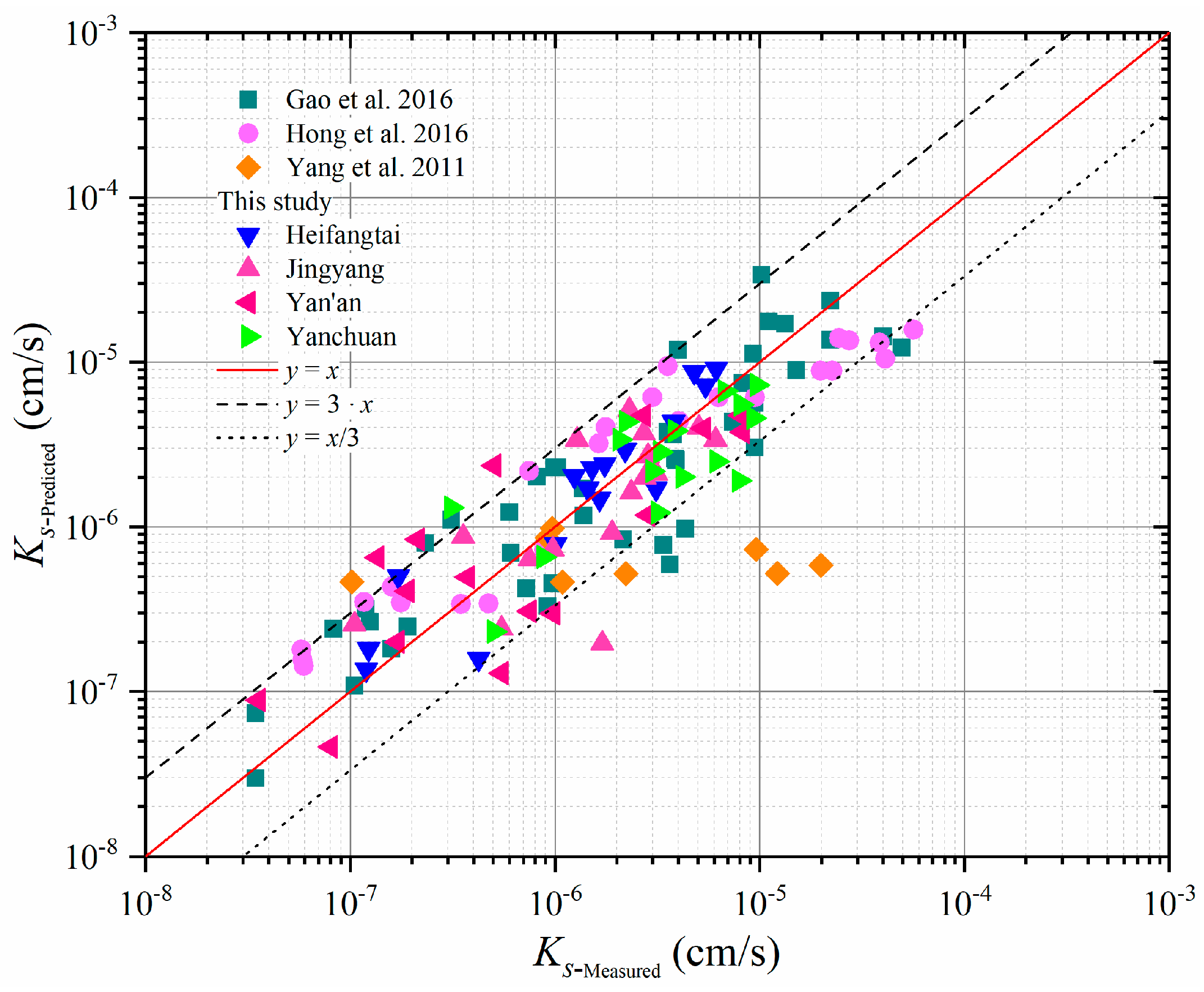
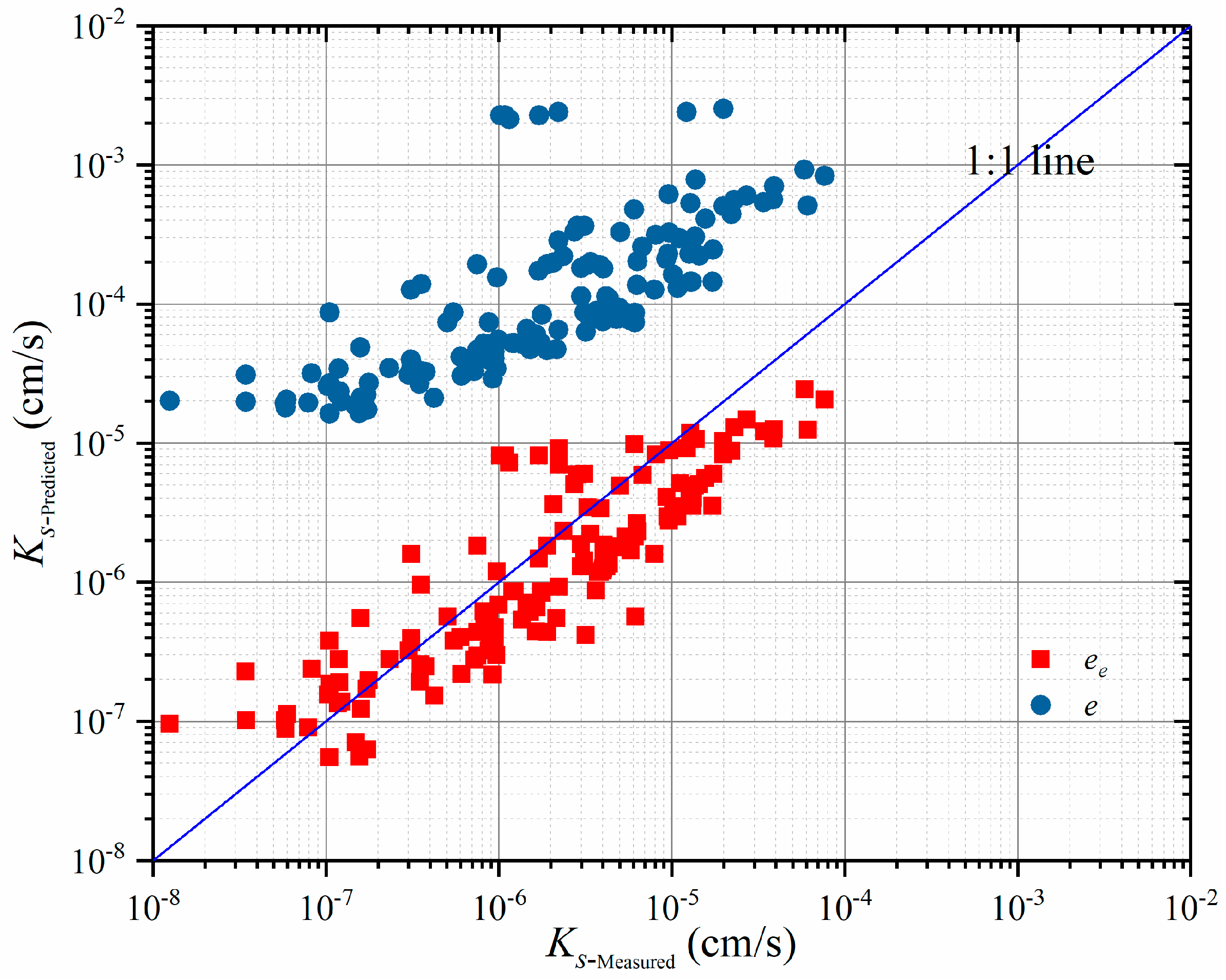
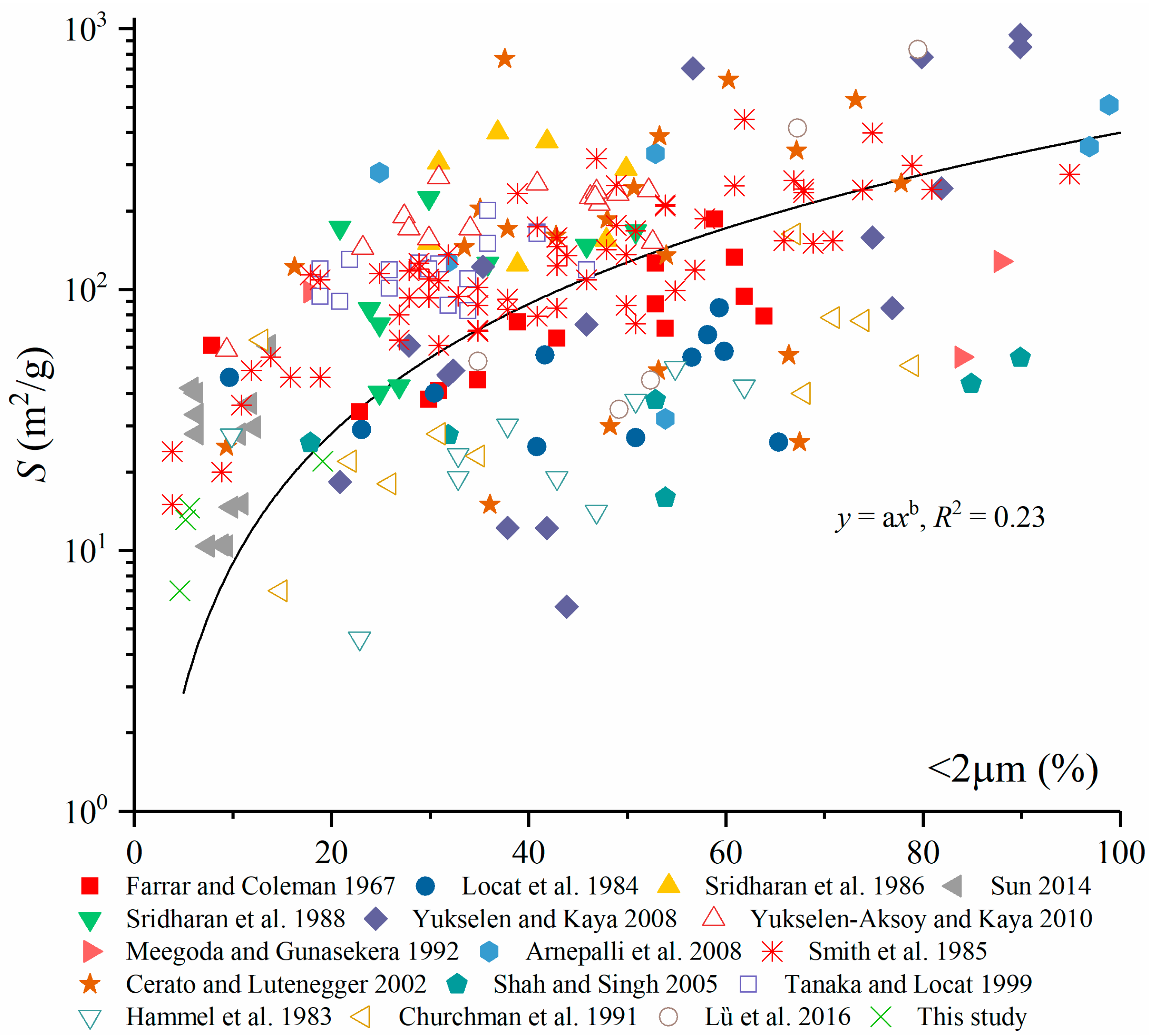
| Properties | Heifangtai | Jingyang | Yan’an | Yanchuan |
|---|---|---|---|---|
| Natural water content (%) | 3.80 | 22.90 | 13.30 | 12.11 |
| Natural density (g/cm3) | 1.35 | 1.89 | 1.81 | 1.65 |
| Dry density (g/cm3) | 1.30 | 1.65 | 1.61 | 1.60 |
| Specific gravity (Gs) | 2.73 | 2.71 | 2.70 | 2.65 |
| Void ratio (e) | 1.10 | 0.68 | 0.62 | 0.72 |
| Liquid limit (LL) (%) | 25.60 | 32.50 | 30.00 | 27.67 |
| Clay: 0–0.002 mm (%) | 4.77 | 19.25 | 5.38 | 5.76 |
| Silt: 0.002–0.05 mm (%) | 69.05 | 65.62 | 89.50 | 76.27 |
| Sand: 0.05–2.0 mm (%) | 26.18 | 15.13 | 5.12 | 17.97 |
| Plastic limit (PL) (%) | 16.50 | 19.50 | 16.40 | 15.14 |
| Plastic index (PI) | 9.10 | 13.00 | 13.60 | 12.53 |
| Activity (PI/CF) | 1.91 | 0.68 | 2.53 | 2.18 |
| Dg (mm) | 0.058 | 0.024 | 0.026 | 0.042 |
| Controlled Dry Density (g/cm2) | Controlled Water Content (%) |
|---|---|
| 1.40, 1.50, 1.60, 1.70 | 12.0, 15.0, 18.0, 21.0 |
| Soil Type and Location | Data Point | Void Ratio e | Liquid Limit LL (%) | Specific Gravity Gs | Experimental Method | Reference |
|---|---|---|---|---|---|---|
| Remolded Malan loess, Yan’an | 14 | 0.52–1.04 | 32.0 | 2.70 | Variable head test | Gao et al. [54] |
| Remolded Lishi loess, Yan’an | 14 | 0.43–0.93 | 19.0 | 2.72 | ||
| Malan + Lishi loess, Yan’an | 14 | 0.51–0.97 | 18.3 | 2.71 | ||
| Remolded Malan loess, Yan’an | 25 | 0.54–1.08 | 31.2 | 2.71 | Variable head test | Hong et al. [55] |
| Remolded loess, Yulin | 8 | 0.45–0.50 | 20.7 | 2.75 | Variable head test | Yang et al. [56] |
| Remolded loess, Yan’an | 16 | 0.40–1.00 | 30.0 | 2.71 | Variable head test | This study |
| Remolded loess, Yanchuan | 16 | 0.50–1.01 | 27.6 | 2.65 | ||
| Remolded loess, Jingyang | 16 | 0.58–1.02 | 32.5 | 2.71 | ||
| Remolded loess, Heifangtai | 16 | 0.44–1.00 | 25.6 | 2.73 |
© 2019 by the authors. Licensee MDPI, Basel, Switzerland. This article is an open access article distributed under the terms and conditions of the Creative Commons Attribution (CC BY) license (http://creativecommons.org/licenses/by/4.0/).
Share and Cite
Hong, B.; Li, X.; Wang, L.; Li, L.; Xue, Q.; Meng, J. Using the Effective Void Ratio and Specific Surface Area in the Kozeny–Carman Equation to Predict the Hydraulic Conductivity of Loess. Water 2020, 12, 24. https://doi.org/10.3390/w12010024
Hong B, Li X, Wang L, Li L, Xue Q, Meng J. Using the Effective Void Ratio and Specific Surface Area in the Kozeny–Carman Equation to Predict the Hydraulic Conductivity of Loess. Water. 2020; 12(1):24. https://doi.org/10.3390/w12010024
Chicago/Turabian StyleHong, Bo, Xi’an Li, Li Wang, Lincui Li, Quan Xue, and Jie Meng. 2020. "Using the Effective Void Ratio and Specific Surface Area in the Kozeny–Carman Equation to Predict the Hydraulic Conductivity of Loess" Water 12, no. 1: 24. https://doi.org/10.3390/w12010024
APA StyleHong, B., Li, X., Wang, L., Li, L., Xue, Q., & Meng, J. (2020). Using the Effective Void Ratio and Specific Surface Area in the Kozeny–Carman Equation to Predict the Hydraulic Conductivity of Loess. Water, 12(1), 24. https://doi.org/10.3390/w12010024





